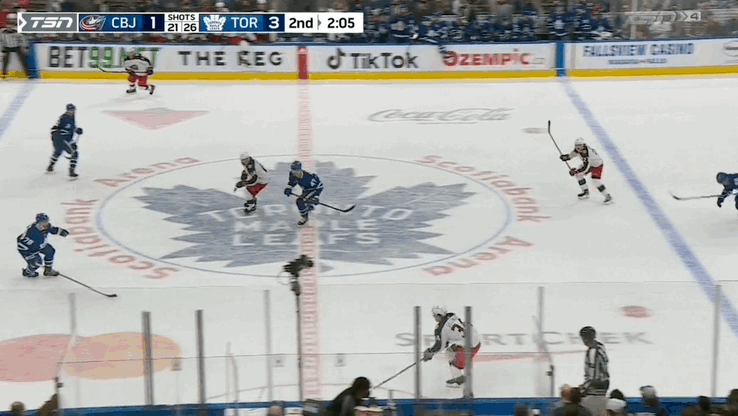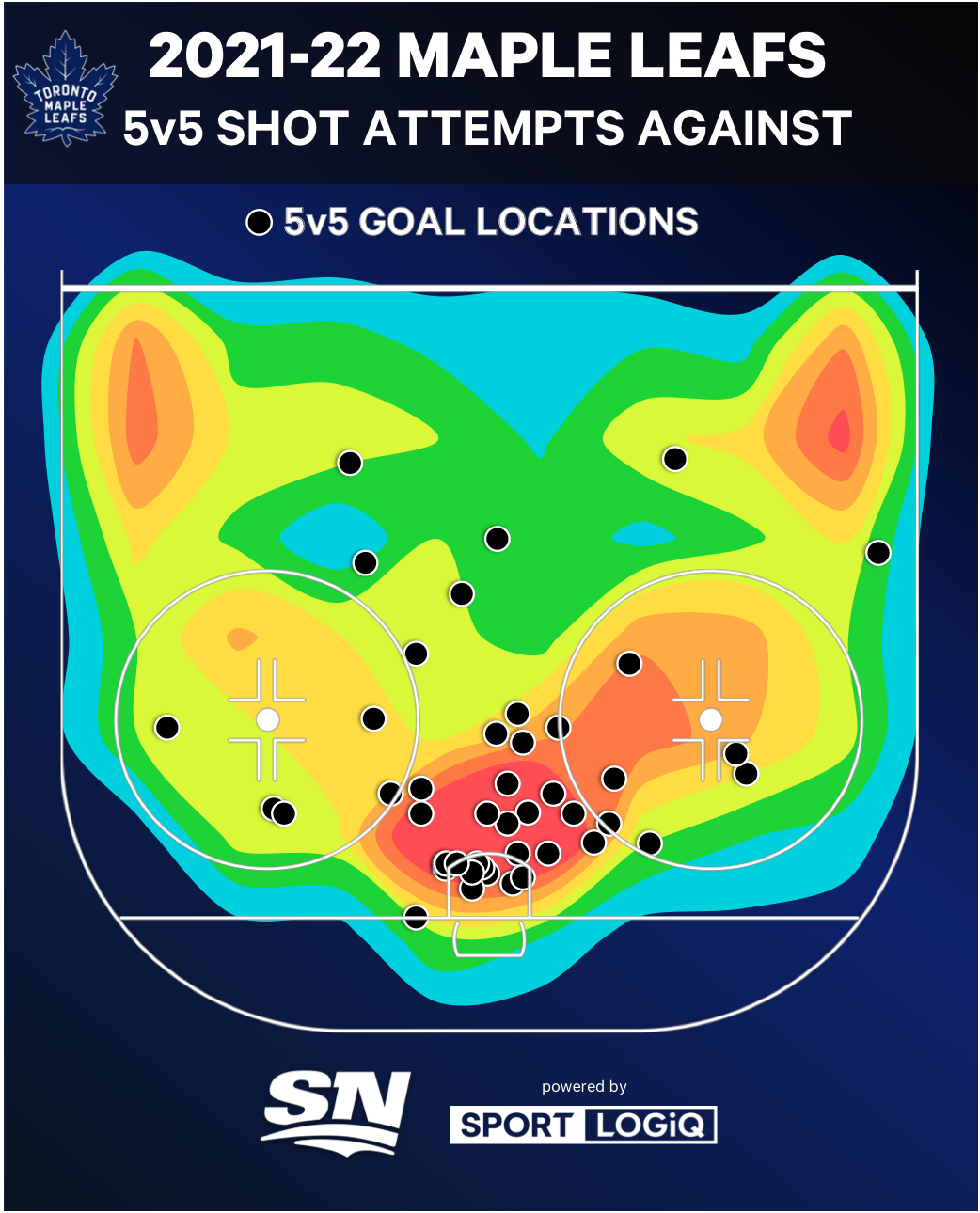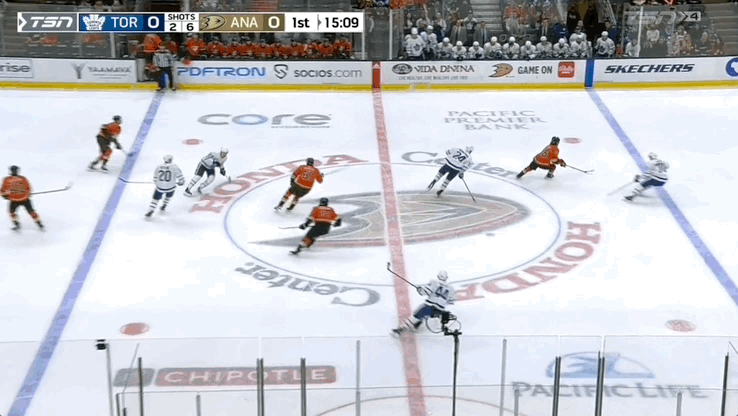The Toronto Maple Leafs have found their footing after a tough start to the 2021-22 season. After going 7-2-1 in their past 10, they’ve moved up to second in the Atlantic Division, with a matching 38 points to the leading Florida Panthers, who have played two fewer games.
Throughout their struggles, Toronto was still generating offence — they just weren’t finishing. And now, even down Mitch Marner for the time-being, there’s still confidence in what they can create.
It’s at the other end of the ice where there are some questions. Jack Campbell has been a huge difference maker in net, but is it because this team is relying on him more? Is this iteration of the Maple Leafs better or worse defensively than last year?
Let’s take a look.
While we could start diving into the penalty kill to talk defence, our focus is going to be at 5-on-5, where the majority of the game is played.
It starts at the blue line. Toronto sees a rate of 36.8 entry attempts against per 60 minutes of play, which is the lowest in the league. They also deny a high rate of those entries into their defensive zone; their denial rate of 48 per cent ranks 11th.

Once in the defensive end, the Leafs are allowing a somewhat high rate of shot attempts against; the 60.1 per 60 they concede is 23rd in the league, and approximately 52 per cent of those reach the net.
But what about the quality of those shots? About 34 per cent of the shots against Toronto are taken from the slot. They allow a rate of 20.5 attempts against from that area of the ice, which puts them in the bottom half of the league at 17th.

Aside from location, there’s pre-shot movement to consider as well. Toronto allows quite a few scoring chances generated on the rush — about 6.65 of the rush attempts per 60 are allowed in the slot. The key is, they don’t allow many goals on those attempts. That, obviously, is one area that shows a reliance on goaltending.

Besides rushes, another way to look at pre-shot moving is with passing. The 2021-22 Maple Leafs limit passes against pretty well; their rate of offensive zone pass attempts is actually the second-lowest in the league. And they’re an above average team at limiting their opponents from quality passes in terms of set ups for slot attempts.
Based on those ‘quality’ factors, the Leafs are expected to allow goals against at a rate of 2.47 per 60 minutes.
How does that stack up to last year?

Similarly, opponents didn’t attempt to enter Toronto’s zone at as high of a rate as other teams in the league. That they don’t allow other teams as many opportunities to even try to cross the blue line as often can be a nod to how well the Leafs possess the puck at 5-on-5. Their zone entry denial rate of 48.1 per cent almost matches this season’s mark.
Within the defensive zone, the 2020-21 Maple Leafs were a better team at limiting shots against. Their rate of attempts against ranked higher at 10th (compared to 23rd this year), as they allowed close to six attempts fewer per 60 minutes.

One notable difference is in how they limited rush chances against last year; the 5.54 slot attempts per 60 they allowed on the rush was the sixth-lowest in the league. They also worked to close passing lanes, as they saw the fifth-lowest pass attempts against in the defensive zone. When Toronto did allow opportunities last season, however, like east-west passes, they were often successful. But the Leafs worked to keep opponents from moving the puck to the slot as they faced the third-lowest rate of pass attempts to that area of the ice in 2020-21.
All together, that contributed to 2.19 expected goals against per 60 — the sixth-best rate in the league last season.
Something both last year’s team and this year’s share in common, though, is their ability to get out of danger. Both iterations of the Maple Leafs have thrived at bringing the puck out of the defensive end with control. As important as it is to protect the quality areas of the ice, it’s also essential to be able to transition back to offence and move the puck up the ice. Few teams carry the puck out at such a high rate. That’s the transitional play these Leafs teams have relied on, versus dump outs.

Still, it’s clear one version of this team has leaned on their goaltender more than the other. But this year, Toronto’s stability in net from starter Jack Campbell has allowed them to do that.
In 22 games last season, Campbell saved 4.3 more goals than expected on the shot attempts he faced at 5-on-5. To balance out that workload and weigh his ice time, it rated out to .25 per 60. Frederik Andersen, in the 24 games he played last season with the Leafs, saved .14 more goals than expected per 60 minutes at 5-on-5.
This season, based on the workload he’s faced in 21 games, Campbell has saved 10.5 more goals than expected. While he has a starting role to open the year this time, his minutes played at 5-on-5 are still less than last year’s total. When accounting for those times, it breaks down to .63 more goals saved above expected per 60. That shows both how stellar Campbell has been, and how much the team has relied on his play between the pipes.

Some of the changes in Toronto’s defensive game can be attributed to slow starts from their defenders. One of those players who has played quite well to open the season is Rasmus Sandin, and the team will be without him for a few weeks. That gives this squad a challenge to step up their play in their own zone without a player who has been a positive influence.
With Toronto’s offence clicking and Campbell playing at such a high level, the Maple Leafs had room to take that step back defensively compared to last year. But to build on years past and take a legitimate step forward — notably in the playoffs — it’s an area with room for improvement.
Data via Sportlogiq
[relatedlinks]









